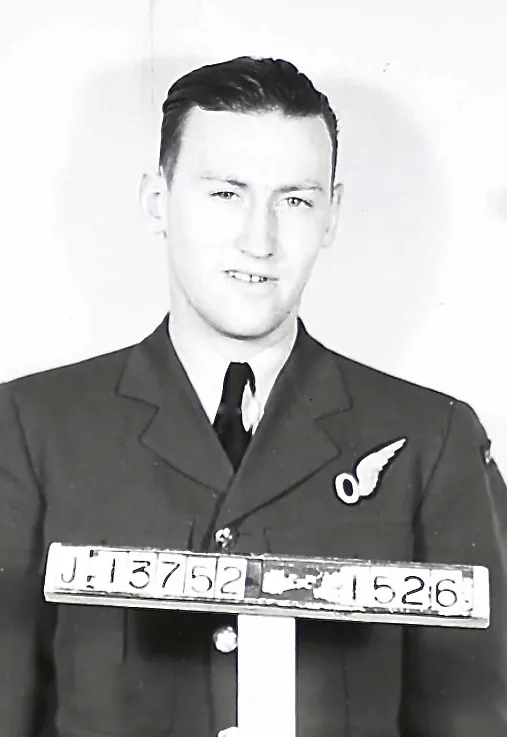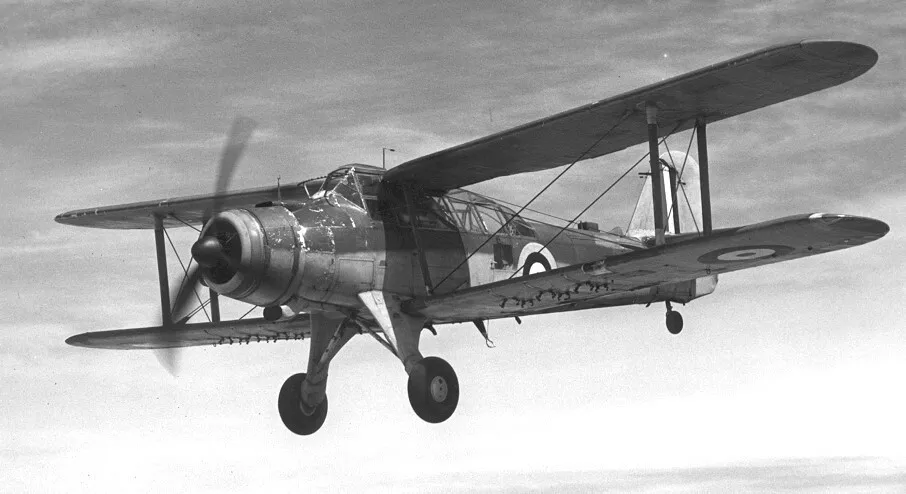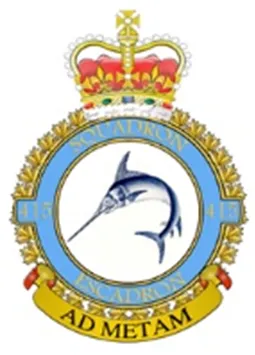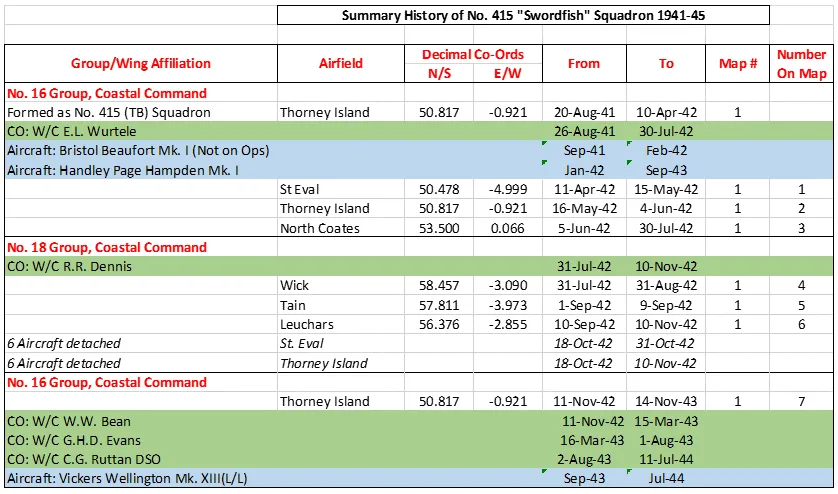Source Harold A Skaarup web page (RN Photo)
Fairey Albacore (Serial No. L7075), 2nd prototype, ca 1940. The Fairey Albacore was flown by No. 415 Squadron, RCAF, and by RCN and RCNVR pilots in service with the Fleet Air Arm, Royal Navy.
Roughly three weeks after No. 415 "Swordfish" Squadron, RCAF, received notification that they were re-equipping with the Albacore, the squadron sent six crews to RAF Station Manston in the UK on a conversion course. They trained on Albacores from the Fleet Air Arm's No. 841 Squadron. No. 841 Squadron handed over the last of their aircraft to the Canadians in November 1943. This left No. 415 (TB) Squadron as the only allied squadron operating the type. The Albacore was nicknamed 'Applecore' by its aircrew. The Albacore was the last operational bi-plane used by the RCAF. (Chris Charland)
The Fairey Albacore was a British single-engine carrier-borne biplane torpedo bomber built between 1939 and 1943 for the Royal Navy Fleet Air Arm. It had a crew of three and was designed for spotting and reconnaissance as well as level, dive, and torpedo bombing. The Albacore served alongside the Fairey Swordfish and was retired before it, being replaced from 1944 by the Fairey Barracuda and the Grumman Avenger.
The Albacore was flight tested at the Aircraft and Armament Experimental Establishment at Martlesham Heath, in the UK. The test pilots noted that the elevators and ailerons were very heavy, the stall with slots free was 'uncomfortable', the front cockpit was too hot in normal summer weather, and the rear cockpit was cold and drafty. On the positive side, Albacore was apparently steady in a dive, with a smooth recovery when carrying a torpedo, and the pilot's view was excellent. Initially equipped with a 1,065 hp (794 kW) Bristol Taurus II engine, these were replaced by the Taurus XII of 1,130 hp (843 kW). Total Albacore production between 1939 and 1943 amounted to 800 including two prototypes, all built at Fairey's Hayes factory and test-flown at what became Heathrow Airport.
No. 826 Squadron, RN, was formed at Ford, Sussex, to fly the Albacore, and received 12 aircraft on 15 March 1940. The squadron went into action on 31 May, attacking E-boats off Zeebrugge and road and rail targets at Westende, Belgium. The squadron moved to Bircham Newton, Norfolk the following month, operating under the direction of Coastal Command until November, making night attacks, laying mines and bombing shipping. Three more Albacore squadrons formed before the end of 1940, No. 829 at Lee-on-Solent, No. 828 at Ford and No. 827 at Yeovilton, the last moving to Stornoway for anti-submarine patrols. Albacores went to sea when Nos. 826 and 829 Squadrons joined HMS Formidable on 26 November 1940, for convoy escort duty to Cape Town, South Africa. Aircraft from these squadrons took part in the Battle of Cape Matapan in March 1941, pressing home their torpedo attacks against the Italian battleship Vittorio Veneto, the first occasion on which they had used torpedoes in action.
By mid-1942 some 15 Fleet Air Arm squadrons were equipped with Albacores, operating from the Arctic Circle on Russian convoys, to the Western Desert, as well as in the Mediterranean Sea and the Indian Ocean. In November 1942, Albacores of Nos. 817, 820, 822 and 832 Squadrons were in action during the Allied invasion of North Africa, flying anti-submarine patrols and bombing enemy coastal guns. Fairey Barracudas began to replace the Albacores in 1942, in all squadrons except No. 832, which was to be equipped with Grumman Avengers. The last two FAA squadrons to give up their Albacores were No. 820 Squadron and No. 841 Squadron in November 1943, aircraft from the latter squadron being passed to No. 415 Squadron, Royal Canadian Air Force, at Manston for use in English Channel operations on D-Day.
No. 415 Squadron continued to operate the Albacore against German shipping until July 1944, when it was transferred to Bomber Command. The Albacores were then used to reform No. 119 Squadron. This squadron used its Albacores against German E-boats and R-boats operating along the Dutch coast, before moving to Belgium in October. The squadron was also used during the D-Day invasion, as part of the air effort to prevent German ships from attacking the invasion convoys. These Albacores were replaced by radar-equipped Fairey Swordfish Mk. IIIs in Jan 1945 for use against German midget submarines and the few remaining E-boats.Harold SKaarup web page with revisions
 Harold A Skaarup Web Page
Harold A Skaarup Web Page
 Albacore Torpedo Bomber
Albacore Torpedo Bomber
 Wikipedia Albacore Torpedo Bomber
Wikipedia Albacore Torpedo Bomber
415 (TB) Sqn Ad Metam ("Swordfish")
History of the Squadron during World War II (Aircraft: Beaufort I, Hampden I, Wellington XIII, Albacore I, Halifax III & VII)
The squadron was the 13th RCAF squadron formed overseas, at Thorney Island, Hampshire, England  on August 20, 1941. It was a originally a torpedo bomber squadron, briefly flying Bristol Beaufort Mk 1 (but not operationally) before transferring to Handley Page Hampden aircraft, with the squadron letters GX. The squadron flew from a number of bases as part of Coastal Command Nos 16 and 19 Groups. Over the course of 1942, these bases ranged from the south of England (St. Eval, Cornwall) to the north of Scotland (Wick, Caithness). In November 1942, it settled at Thorney Island for a year before moving to Bircham Newton, Norfolk, in November 1943. From September and October 1943, the squadron flew Wellington Mk. XIII and Fairey Albacore Mk. I, the latter having the squadron code of NH. The squadron was active on D-Day, laying smoke screens for the Allied shipping. After D-Day, there was less need for maritime operations, and the squadron was designated 415(B), was equipped with Handley-Page Halifax III and VII aircraft, and joined 6 Group (RCAF) of Bomber Command, flying from East Moor, Yorkshire
on August 20, 1941. It was a originally a torpedo bomber squadron, briefly flying Bristol Beaufort Mk 1 (but not operationally) before transferring to Handley Page Hampden aircraft, with the squadron letters GX. The squadron flew from a number of bases as part of Coastal Command Nos 16 and 19 Groups. Over the course of 1942, these bases ranged from the south of England (St. Eval, Cornwall) to the north of Scotland (Wick, Caithness). In November 1942, it settled at Thorney Island for a year before moving to Bircham Newton, Norfolk, in November 1943. From September and October 1943, the squadron flew Wellington Mk. XIII and Fairey Albacore Mk. I, the latter having the squadron code of NH. The squadron was active on D-Day, laying smoke screens for the Allied shipping. After D-Day, there was less need for maritime operations, and the squadron was designated 415(B), was equipped with Handley-Page Halifax III and VII aircraft, and joined 6 Group (RCAF) of Bomber Command, flying from East Moor, Yorkshire  (RCAF No 62 Base),where it remained until the end of hostilities. Its squadron code was changed to 6U [this is according to Moyes and Wikipedia, but Kostenuk gives "GU", which may be a misprint]. Its last mission was on April 25, 1945. The squadron was disbanded at East Moor on May 15, 1945.
(RCAF No 62 Base),where it remained until the end of hostilities. Its squadron code was changed to 6U [this is according to Moyes and Wikipedia, but Kostenuk gives "GU", which may be a misprint]. Its last mission was on April 25, 1945. The squadron was disbanded at East Moor on May 15, 1945.
In the course of the war, the squadron flew 1645 torpedo bomber operations for a cost of 33 aircraft, and was credited with 5 ships sunk, with 2 damaged and 2 others shared. In its bomber role, 1608 sorties were flown for the loss of 22 aircraft, dropping 5041 tons of bombs and 798 tons of incendiaries. The crews were awarded 1 DSO, 86 DFC's and 1 Bar to DFC, 1 GM and 9 DFM's. Battle Honours were: Atlantic 1942, English Channel and North Sea 1942-44, France and Germany 1944-45 Biscay Ports 1944, Ruhr 1944-45, German Ports 1944-45, Normandy 1944, Rhine, Biscay 1942-43.Wikipedia, Kostenuk and Griffin
Squadron History (Bomber Command Museum PDF)
Maps for Movements of 415 Squadron 1941-45
MAP 1: 415 Squadron Movements Dec 1941-Aug-42 (right-click on image to display enlarged in new tab)
|
MAP 2: 6 Group Bomber Bases 1943-45
|
415 Squadron History Summary 1941-45
415 Squadron History Summary 1941-45 Page 2
History of the Squadron Post-WWII (Aircraft: Argus, Aurora)
The squadron was re-established as a Maritime Patrol squadron on 1 June 1961 at RCAF Station Summerside, Prince Edward Island  , and equipped with the Canadair CP-107 Argus. The Squadron was quick to establish a Canadian endurance record on 26 July 1961, flying 30 hours and 20 minutes, non-stop. During its two decades at Summerside, the Swordfish squadron conducted a variety of missions including anti-submarine, fisheries and pollution, and Northern sovereignty patrols, operating from an ever-increasing number of deployment locations. In 1964, the Squadron assumed the Search and Rescue duties for the Maritime Air Command. In 1981, all the Maritime Patrol Squadrons converted to the Lockheed CP-140 Aurora aircraft and all the East Coast CP-140 squadrons were consolidated at Canadian Forces Base (CFB) Greenwood
, and equipped with the Canadair CP-107 Argus. The Squadron was quick to establish a Canadian endurance record on 26 July 1961, flying 30 hours and 20 minutes, non-stop. During its two decades at Summerside, the Swordfish squadron conducted a variety of missions including anti-submarine, fisheries and pollution, and Northern sovereignty patrols, operating from an ever-increasing number of deployment locations. In 1964, the Squadron assumed the Search and Rescue duties for the Maritime Air Command. In 1981, all the Maritime Patrol Squadrons converted to the Lockheed CP-140 Aurora aircraft and all the East Coast CP-140 squadrons were consolidated at Canadian Forces Base (CFB) Greenwood  . On the afternoon of 24 July 1981, Argus 736, call sign "Sidney 02", conducted a fly-past for a ceremonial parade to celebrate 415 Squadron’s welcome to Greenwood; its Change of Command ceremony, and, the last official Canadian Forces flight of the Argus. In 1982, the Squadron received its Standard in recognition of 25 years of dedicated service to the Crown and the people of Canada.
. On the afternoon of 24 July 1981, Argus 736, call sign "Sidney 02", conducted a fly-past for a ceremonial parade to celebrate 415 Squadron’s welcome to Greenwood; its Change of Command ceremony, and, the last official Canadian Forces flight of the Argus. In 1982, the Squadron received its Standard in recognition of 25 years of dedicated service to the Crown and the people of Canada.
Operationally, Iraq’s invasion of Kuwait in 1990 prompted Canada to send a naval task group to enforce the United Nations’ resolutions. 415 Squadron was tasked to support this task group during its work-up phase during transit from Halifax to the Mediterranean Sea. The Aurora exercised the self-defense capability of the Canadian Task Group and provided surface surveillance. In 1993, Operation SHARP GUARD brought crews from 415 Squadron to Sigonella, Sicily,  where they flew surveillance patrols in the Adriatic in support of the United Nation’s arms embargo of the Former Republic of Yugoslavia. The Squadron later participated in Operation ASSISTANCE, providing humanitarian assistance to the people of Manitoba during the great flood of 1997. Throughout the 80s and 90s, anti-submarine warfare training and anti-submarine patrols remained the focal point for 415 Squadron. With the end of the Cold War and new asymmetric threats emerging, the Aurora fleet became more involved in overland missions; to align the CP140 fleet with this new reality, all the CP140 squadrons were rebranded as Long Range Patrol (LRP) Squadrons. 415, along with the other LRP Squadrons, were active participants in Operation APOLLO, deploying crews to the Arabian Sea region in support of the American-led Campaign Against Terrorism (CAT) following the events of September 11, 2001. The first two crews rotated through on deployments of six months duration. For the remainder of the operation, crews were rotated every 56 days. The CP-140 commitment to Operation APOLLO ended in July 2003.
where they flew surveillance patrols in the Adriatic in support of the United Nation’s arms embargo of the Former Republic of Yugoslavia. The Squadron later participated in Operation ASSISTANCE, providing humanitarian assistance to the people of Manitoba during the great flood of 1997. Throughout the 80s and 90s, anti-submarine warfare training and anti-submarine patrols remained the focal point for 415 Squadron. With the end of the Cold War and new asymmetric threats emerging, the Aurora fleet became more involved in overland missions; to align the CP140 fleet with this new reality, all the CP140 squadrons were rebranded as Long Range Patrol (LRP) Squadrons. 415, along with the other LRP Squadrons, were active participants in Operation APOLLO, deploying crews to the Arabian Sea region in support of the American-led Campaign Against Terrorism (CAT) following the events of September 11, 2001. The first two crews rotated through on deployments of six months duration. For the remainder of the operation, crews were rotated every 56 days. The CP-140 commitment to Operation APOLLO ended in July 2003.
As a follow-on to Operation APOLLO, the LRP fleet, under the direction of 1 Canadian Air Division Headquarters, developed a Squadron Vanguard posture for future potential missions. 415 Squadron was the first unit selected, holding Vanguard from 1 April to 30 September 2004, maintaining a high readiness to rapidly deploy worldwide. In September 2004, coincident with the close of 415 Squadron’s Vanguard liability period, came the call to support NATO naval units in the Mediterranean conducting Operation ACTIVE ENDEAVOUR, with the mission to deter, monitor and intercept potential threats of terrorism in the Mediterranean Sea; to defend NATO member nations against terrorists operating at sea; and, to demonstrate resolve and presence in the campaign against terrorism. By mid-October, one crew and support staff from 415 Squadron along with 14 and 19 Wing (Comox) technicians and aircrew, were in theatre and flying Operation SIRIUS missions out of Sigonella. Soon thereafter, on 29 July 2005, 415 Squadron was stood down for a second time.
In 2015, it was decided to merge the capabilities and expertise of 14 SES and MPEU into a single unit that would optimize frontline operator and engineering input into the ongoing development of the platform, and the associated mission/training support systems. This would allow for a more efficient, holistic approach to deal with the software/hardware complexities and to fully realise the vast potential of the AIMP-upgraded Aurora, now dubbed the CP140M. As such, after a 10-year absence, 415 Squadron and the Swordfish were stood up to once again proudly serve the government and people of Canada.







